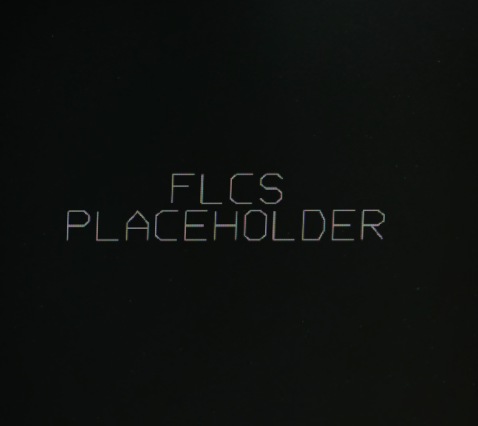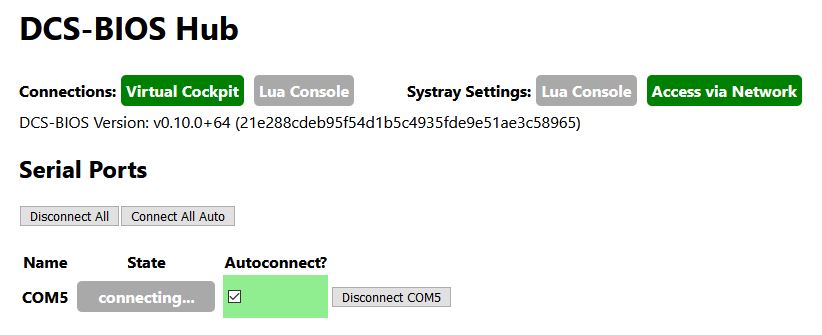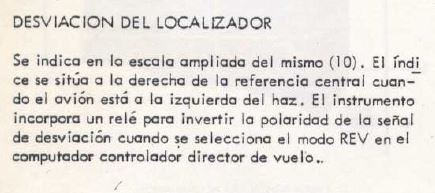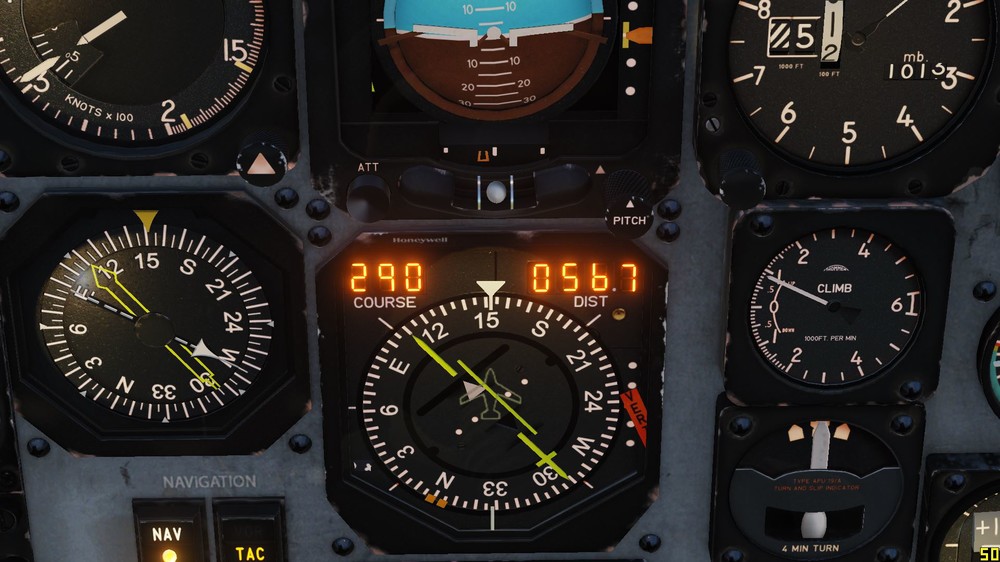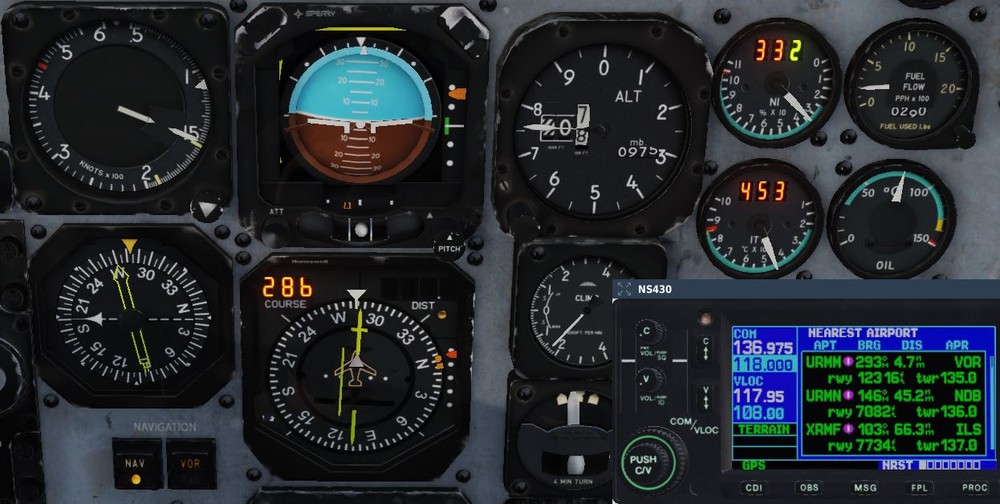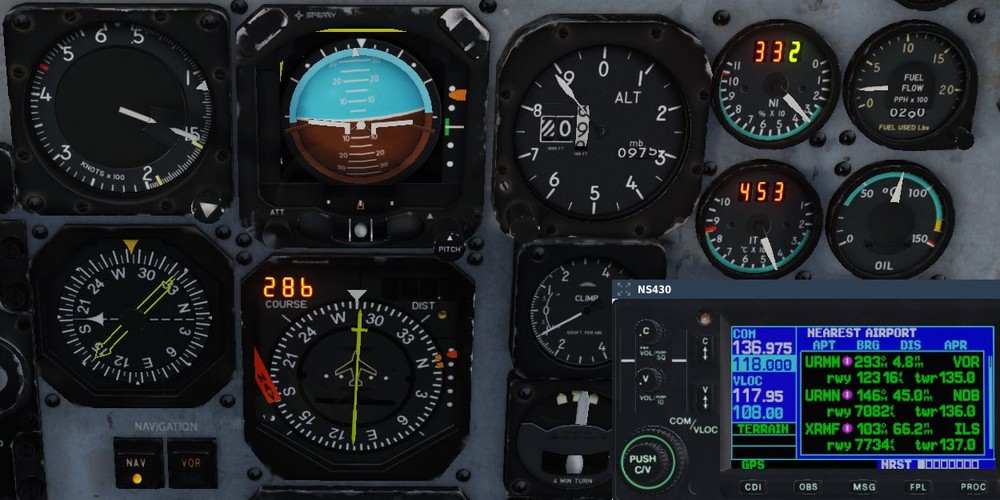-
Posts
220 -
Joined
-
Last visited
Content Type
Profiles
Forums
Events
Everything posted by frumpy
-
I'm just trying to understand what this code does: void onAoaUnitsChange(unsigned int newAoaValue) { if (newAoaValue < 20000){ // 20000 is the transmitted value for about level flight in the A-10C digitalWrite(RedLed, LOW);} if (newAoaValue > 20000){ digitalWrite(RedLed, HIGH);} } DcsBios::IntegerBuffer aoaUnitsBuffer(0x1078, 0xffff, 0, onAoaUnitsChange); As far as I understand: IntegerBuffer is a function of DCS BIOS. I don't know what aoaUnitsBuffer does. The adress 0x1078, 0xffff is read and stored in onAoaUnitsChange. onAoaUnitsChange is then called and the stored value is transmitted. Within this function, it is called newAoaValue. I can then use newAoaValue to control the LEDs. Is there any way I can debug this? Like printing the state of the variables somewhere, so I can check why the code does not do what it should? Is there any code repository with examples on how to use BIOS? The handbook is a bit short on these things.
-
Thanks. I'm reading the manual along, but I rather learn by example code than by description. I am trying to read onAoaUnitsChange, which can be converted to the AOA in degrees. The goal is to drive the LED at a certain AOA, independent of the indexer.
-
Hi there, I am trying to learn the basics of DCS-BIOS. Right now the goal is to display the AOA of the A-10 on LEDs. The AOA of the A-10 reads a value of about 20k in level flight. Here is the code: define DCSBIOS_IRQ_SERIAL #include "DcsBios.h" int RedLed = 16; //==================== Main =================================== void onAoaUnitsChange(unsigned int newAoaValue) { if (newAoaValue < 20000){ digitalWrite(RedLed, LOW);} if (newAoaValue > 20000){ digitalWrite(RedLed, HIGH);} } DcsBios::IntegerBuffer aoaUnitsBuffer(0x1078, 0xffff, 0, onAoaUnitsChange); // ============================== Essentials ================== void setup() { DcsBios::setup(); } void loop() { DcsBios::loop(); } Should be fairly simple, no? It does not light up any LED. What's wrong? Thanks, Olli
-
Disregard, please. Of course the DCS-Bios program has to be loaded in the background :->
-
Hi there, I am new to DCS BIOS and I have trouble getting it to work. Its a Nano-clone, CH340 driver installed on Win10. I followed along the manual on how to install BIOS. I installed the script and the Arduino library. COM5 works and Arduino can upload the sample program of the A-10 Master Caution. Still, I cannot connect DCS-BIOS to the Arduino? Anyone has an idea why this is? Thanks, Olli
-
My bad, sorry. I did not realize this is only valid for the FD, so HSI and LOC needles are not affected.
-
I have tried the REV when being backcourse, but it did not work as described.
-
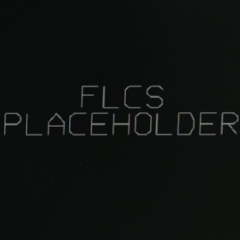
Is the map worth of money? even when on Sale?
frumpy replied to GumidekCZ's topic in DCS: Normandy 1944
I bought the map (and yes, the 3D models too... what are they good for?), but basically I use it only for a Mirage A/A refuel mission. I feel the 3 other maps are better with the terrain structure and colors. I am a bit excited about the upcoming Syria map, but will wait for reviews first. -
Any comment on the function of REV-button? While the handbook starts with mentioning the XT computer at that time, I think I could explain more on the function of the flight computer. Hard to find any information in english.
-
Comparing the L39 flaps with the C101 doesn't work, due to very different extension angles. Still I wonder, if the real C101 stalls that easily when retracting the flaps at 120 kts? Is there any news on the thrustvector?
-
I wonder how the A-10 and F-16 (once it's done) will compare systemwise?
-
I feel the Viper is pretty, looks good and the FBW works like a charm. However, I am frustrated too with the implementation of some systems (I don't care about weapons), having many placeholders on the MFD-pages. For now, I went to BMS - with growing eagerness. Not as pretty, but a real hardcore F-16 simulation.
-
Also, I wonder if the 3 lights AOA indexer in the CC is shown correctly? I did not find a condition where it's turned off. I think it should turn off during flight, e.g. when the gear is raised. Edit: I checked with other aircraft. Seems to be on during flight on most aircraft. I wonder if that's not rather a distraction than a help.
-
Hi there, I just noticed the roll index of the Viggen may be pointing in the wrong direction. Usually military ADIs use an earthpointer, that is that the pointer is pointing always to the ground - since it's at the bottom of the ADI, it shows the direction of the turn too. The way it is shown now, is that the pointer moves opposite.
-
Thanks for the backcourse comments. I have to catch up with IFR training, thats one reason why I got the C101. The attachment is from the "C-101 manual de vuelo", page 57 of the PDF.
-
Okay, it's a bit hard to understand its features with the spanish handbook. :) I checked Google translator on the localizer needle: So as far as I understand, depressing the REV button should reverse the localizer needle indication? If so, pressing the button in the EB (havent checked the CC) should do it, but nothing happens.
-
So the distance indicator is only for the TACAN, ok. I am a bit embarrassed here. Of course, backcourse. More groundschool for me. Still, why is the localizer needle moving? It's only for localizers, is it?
-
Did you check out Rudel's missions? It's in the user content download section of DCS.
-
Roberto, did you have time to check my above post? I found some more things, I just want to be sure you are taking notice. When being over Georgia, I set Tacan to 44X and got a DME. When setting the VOR/TAC switch to VOR, the DME is still displayed. Why is this? What is the function of the Navigation Control Transfer Button? One other thing I dont understand is the localizer deviation pointer in the ADI. When is it active? What does it do? Is it connected to the flight computer? The below screenshot shows a "fly right into the 290 radial" on the HSI, while the localizer pointer is active too - telling me to turn left. Also, there is a displaced part of texture on the bottom left of the HSI, close to 30°. One more thing.. when being on the ground and ejecting, I can still move the control surfaces. Havent tried in flight. Thank you, Olli
-
I feel if a 10° tilted oval fuselage creates more lift than a 10° tilted wing, then aerodynamics have to get a second thought. Okay, it's only a small effect, so lets leave it. One thing I noticed when following the procedure of retracting the flaps at 120-125 kts (4800kg) the AOA will rise suddenly and will activate the stall warning if the pilot is not reacting quickly. Not nice being close to the ground in a low powered aircraft, especially in a trainer aircraft. I compared the AOA of the L39 (4500kg, due to smaller wing area) with the C101. While the AOA with flaps retracted is pretty similar in both modules above 240 km/h, the AOA of the C101 is significantly higher with flaps in takeoff position. I am not completly sure on how to interpret this, but it seems like they are not generating enough lift? There seems to be something with the thrust vector. When at 250 kts, increasing the thrust will lower the nose, while lowering the thrust will lift the nose. I think it should be the other way around, since the engine is below the airplanes CoG. Is there a public bug list? The is a thread from 2015, but I cannot find a list there. Vibora, you wrote something like the pitch axis is being worked on, what are the symptoms that you are working on? I am interested in helping to improve the flight dynamics, perhaps there is something I can do :) Thanks, Olli
-
Hi Roberto, thanks for taking care. As for the baro knob, I am using the mousewheel. It takes 10 clicks to take the pressure from 1013 to 1014 mb, which is quite a lot. Keyboard bindings work fine, but I think increasing the speed by 5 (2 clicks per mb) would add to immersion. As for the speed, if possible a finer resolution (with the mouse and keyboard) would help. The steps at around 250 kts are 3-4 kts, so setting e.g. 252 kts is not feasible. Thanks on the thrust settings. I didn't realize the ITT is the limiting factor. Concerning the ILS, I'll do some more tests and consider reporting to ED. I don't agree on ice accretion while standing on the ground. I learned in unfavorable conditions, icing could start in flight below 15°C. However I don't see why my pitot tube should get plugged just by standing on the runway at 8°C? I don't know about the engine, though. I found two pics of the cockpit: I noticed some differences in the ADI when being cold&dark: -The right pointer for the FD or glideslope is centered in the simulation, while to me it looks like it is coupled to the vertical deviation indicator of the FD. So in the sim it's in the middle, while on the lower photo it's on top. Same with the localizer pointer. - the 3 localizer marks are much taller on the photo. - Concerning the red-white dashed indicator, on the photo it's down at the very bottom, in the sim it's at -10° pitch. The flaps and airbrake indicator are black in the sim and white on the photos. The gear indicator is red on the photo, and black in the sim. One more question on the cockpit textures: I think they look quite used, like someone tried to clean his hands using the panel and after that used some sand-paper to file off paint? :) I'm am thinking about reworking this myself, since I think avionics are delicate instruments that should be handled with care. Is this feasible to do with Photoshop? Thanks, Olli
-
Hi Vibora, Thanks for the link on bank angle. I knew the TAS/10+7 rule is a rule of thumb, but now I know exactly how much bank is needed. It's great to hear the turn rate is spot on! :) I am not sure about the nose-up attitude on rolling. Where do you think does the vertical component of adverse yaw come from? After all, with a bank we are losing a part of the vertical lift. Since the ailerons of the C101 are deflected in a differential way (-17/+24°) this should minimize adverse yaw anyway. I mean after all it would mean that when I'll lose the elevator, I can control altitude by the means of inducing adverse yaw? I also had contact with a senior flight model developer, asking him about the climb. He said there is no lift component and due to design adverse yaw should be very little, if any. Thank you.
-
Hi Ramsay, your right about the wind. The mission editors windvector pointing towards the right looked to me like there would be some headwind. :) Concerning the ILS cone, the DCS one seems to be pretty short an narrow. Can anyone confirm this? I've checked with several simulators, flying a downwind into the cone makes the glideslope appear at around 7 nm, so I can turn to base or final at around 10nm. Cannot do this with the C101, as I dont even get the signal. I remember having some ILS trouble with the Mirage too. As for the engine quitting, it's 10 degrees celsius so icing shouldn't be an issue.
-
Hello, I took the EB for a ride in instrument conditions and noticed a few things: 1. the HSI lacks a few marks, 90° left and right and 180 at the bottom - note that the 90° right mark is also the center indication fir the glideslope 2. the baro knob turns very slow, can the speed be increased? 3. the speed knob has a resulution of 2-3 kts, can this be reduced to 1 kts? 4. is there a table of applicable thrust settings? I did not find a N1 setting for climb&cruise power 5. The ILS is behaving weird. Usually if I turn from upwind to downwind at 3000 ft, the ILS cone should appear around 7 nm away from the airport. I did not notice this, I could not get the cone. When turning final after a loong (20nm) downwind, the ILS indications appear at about 12.5nm. Beyond that, there is no signal. 6. The localizer got lost for some reason at 4.8nm, see the screenshot. 7. When standing on the runway with engines running, after about 20 mins I increased the throttle and the engine quit. This is reproduceable, so I wonder whats going on? I attached the mission file and video - you can see this at the very end. Thank you. c101 ils issues.trk c101 eng fail.trk C-101 EB IFR takeoff.miz
-
Hi Vibora, thanks for taking a look at it. Check out the video in the first post, just at the end I blocked my pitch axis and just rolled left and right and got the positive vertical speed. You can also see this effect when pointing the nose at a ground target and correct only left and right. I don't see how adverse yaw should have any positive effect on pitch. (Just by yawing in level flight I'll get a slight descent rate, which is correct.) I did some testflights again. This time at about ISA and flew 1000 ft (mission file attached). 230 TAS is about 227 IAS, which I tried to keep as good as possible. :) 4 minute turn using the bank indicator is 3:50min left and right, so if pointer indication is increased by a factor of 1.04, it should be pretty much dead on. I noticed left turns at 1000', 227 IAS and 30° are 2:14min left, 2:21min right (did each turn twice to average the time). I am not sure about the precision of the TAS/10+7 rule so *maybe* the C101 turns a bit slow in general. I checked this in other sims too, the rule of thumb was pretty much dead on. But why are the left turns quicker than right turns? Well, I noticed that the bank scale for a right turn is a bit off. It displays 30° bank, but the DCS value (F2 view) is 29°. It's correct on the right side (left turn). I know this is a bit picky, as this is a consumer and not a professioinal product. I bought this module yesterday, as the overall experience convinced me and I want to support the developers for their art. I believe most things are not that hard to correct and I would appreciate if the devs could take care of it. Thank you! C-101 EB Testflight ISA CAVOK.miz

